1. Biography
Sri Chinmoy's life journey began in rural India, transitioned to a disciplined spiritual ashram, and culminated in a global movement centered in the United States, marked by the establishment of numerous meditation centers worldwide.
1.1. Early Life in India
Chinmoy was born as the youngest of seven children on 27 August 1931, in Shakpura, Boalkhali Upazila, Chittagong District of East Bengal, British India (now Bangladesh). His father, Shashi Kumar Ghose, was a former railway ticket inspector and banker, and his mother, Yogamaya Ghose, was a deeply religious homemaker. Chinmoy experienced significant loss at a young age, with his father dying from illness in 1943, followed by his mother a few months later. He began practicing meditation at the age of 11. In 1944, at the age of 12, Chinmoy joined his siblings at the Sri Aurobindo Ashram in Pondicherry, South India, where his elder brothers Hriday and Chitta were already established. It was Chitta who gave him the name Chinmoy, meaning "full of divine consciousness."
1.2. Spiritual Practice at Sri Aurobindo Ashram
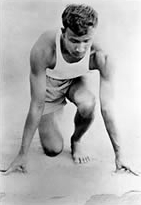
Chinmoy spent the next 20 years, from 1944 until 1964, within the Sri Aurobindo Ashram, dedicating himself to intensive spiritual practice. His daily routine included deep meditation, rigorous study of both Bengali literature and English literature, and active participation in athletics. In his teenage and twenties, he was a short-distance runner and decathlete. He also contributed to the ashram's operations by working in its cottage industries.
In 1955, Chinmoy became the personal secretary to Nolini Kanta Gupta, the General Secretary of the ashram, who was responsible for administration and translating Bengali documents into English. During this period, Chinmoy himself published articles on Indian spiritual masters and continued to fill his personal notebooks with poems, songs, and reflections on life within the ashram.
1.3. Move to the United States
In 1964, at the age of 33, Sri Chinmoy felt an inner calling to serve spiritual seekers in the West. On 13 April 1964, he emigrated to New York City, invited by American sponsors connected with the Sri Aurobindo Ashram, including Sam Spanier and Eric Hughes. For his first year in the United States, he worked as an assistant in the passport and visa department at the Indian consulate under L.L. Mehrotra. Despite his lack of formal education, he received support from colleagues and superiors, who encouraged him to give talks on Hinduism.
His public engagements began with lectures at universities, and later expanded to the United Nations. In 1965, he was invited to the Guggenheim Museum and, with the support of the Asia Society, performed three musical compositions. Later that year, he began publishing the monthly AUM magazine.
1.4. Establishment and Expansion of Centers
On 22 July 1966, Sri Chinmoy established his first Sri Chinmoy Center in San Juan, Puerto Rico. This marked the beginning of his formal spiritual guidance outside the ashram, and it was around this time that he began to be known as "Sri Chinmoy." These centers were founded to teach his spiritual philosophy and meditation practices, emphasizing a path of moderate brahmacharya (celibacy). By the late 1970s, the main study centers were located in New York, Florida, and the West Indies. Over the subsequent decades, the movement saw significant expansion, with Sri Chinmoy Centers opening in numerous cities across the United States, Europe, Australasia, South Africa, and South America, ultimately totaling 350 centers in 60 countries and attracting an estimated 7,000 students worldwide.
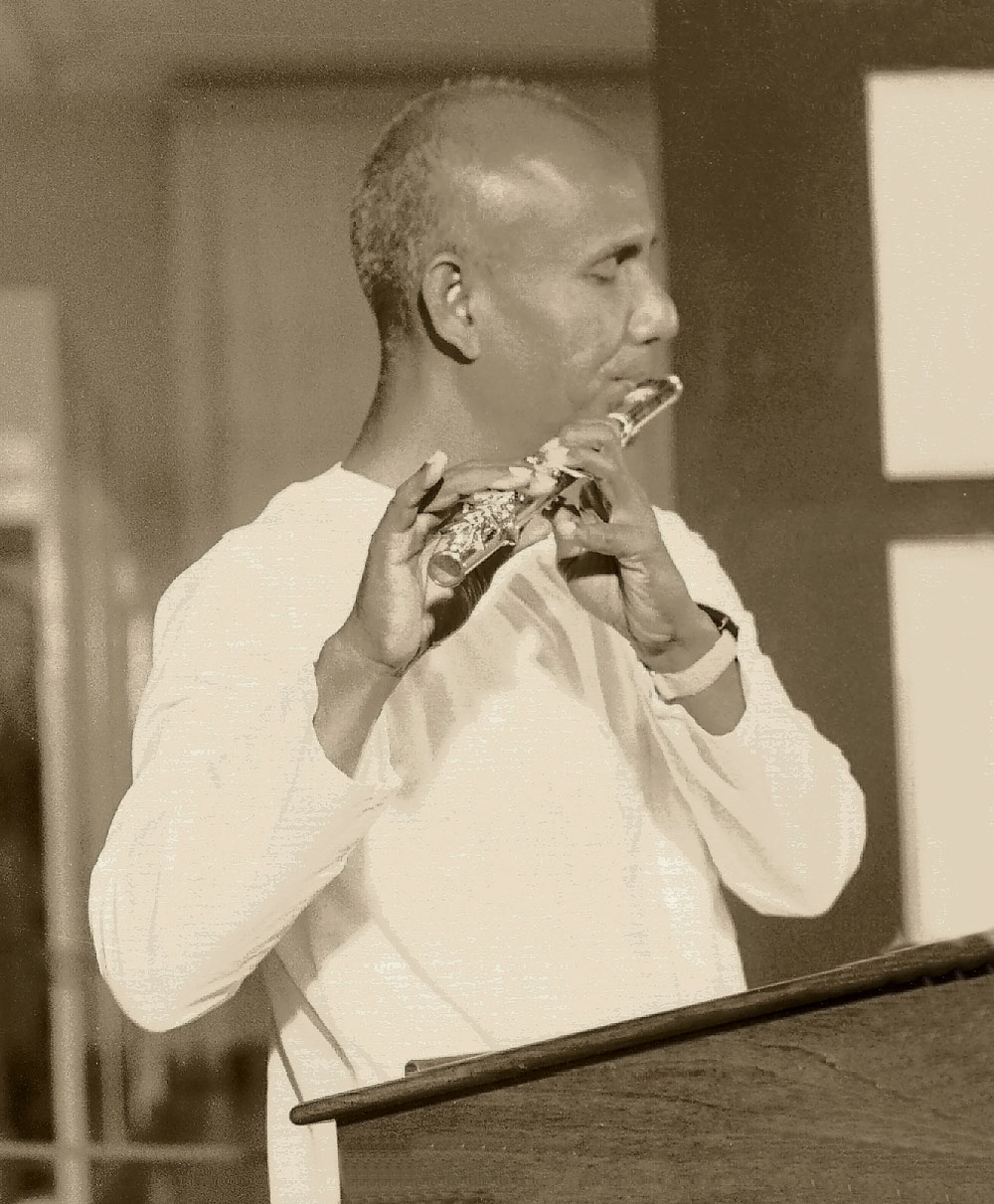
In the late 1960s and early 1970s, Sri Chinmoy continued to lecture at universities across the U.S. In 1974, he delivered lectures at 50 universities in 50 states, which were later published as a six-part book series titled 50 Freedom-Boats to One Golden Shore (1974). His travels and lectures continued through the 1970s and 1980s across Europe, Asia, and Australia, leading to the publication of The Oneness of the Eastern Heart and the Western Mind. He also published numerous books, essays, spiritual poetry, plays, and commentaries on the Vedas.
In 1973, The New York Times reported that Sri Chinmoy was "revered in India as one of the few holy men to have reached Nirvikalpa Samadhi, the absolute highest level of consciousness."
During the 1970s, Chinmoy began playing and composing music on the flute and esraj. In 1984, he initiated free 'Peace Concerts' around the world, with his first major concert in Montreal drawing an audience of 19,000 people. His musical endeavors and spiritual path attracted notable musicians such as Carlos Santana, John McLaughlin, Narada Michael Walden, Roberta Flack, Clarence Clemons, and Boris Grebenshchikov. Sri Chinmoy offered these artists a disciplined spiritual path that prohibited recreational drugs, including alcohol, and encouraged music and poetry as expressions of gratitude to the Divine.
Santana and McLaughlin were followers for several years. In 1973, they released the album Love Devotion Surrender, inspired by Sri Chinmoy's teachings. McLaughlin, a follower from 1970 to 1975, formed the Mahavishnu Orchestra, named after the spiritual name Sri Chinmoy had given him. McLaughlin introduced Santana to the guru, and Santana and his wife Deborah were Chinmoy followers from 1972 to 1981. Santana, who received the spiritual name Devadip (meaning "Lamp of God," "Eye of God," and "Light of God") from Chinmoy, released three albums under this name: Illuminations (1974), Oneness (1979), and The Swing of Delight (1980). While Santana later stated that their relationship soured in the 1980s, with Chinmoy reportedly becoming "vindictive" upon his departure, Santana also acknowledged taking "much that was good" from his time with the guru, expressing gratitude for those 10 years in 2017.
Other notable figures who became followers included spiritual teacher Frederick Lenz, who later became a guru himself after leaving in 1981, and spiritual author Lex Hixon, who was a member of the Sri Chinmoy Centre in the 1970s.
2. Teachings and Philosophy
Sri Chinmoy's teachings centered on a practical spiritual path for modern seekers, emphasizing inner transformation, meditation, and a disciplined lifestyle, all within a framework of universal love and interfaith harmony.
2.1. Core Concepts
Sri Chinmoy taught that spiritual progress could be achieved by following a path of love, devotion, and surrender, a practice akin to Bhakti Yoga. He described divine love as a process of self-offering and self-expansion. His path did not advocate for a complete withdrawal from the world or extreme asceticism; instead, it presented a middle way where seekers could renounce or transform negative qualities that hindered their union with the Divine.
A fundamental element of his teachings was the concept of "self-transcendence." This involves setting new goals and extending beyond one's perceived limitations, which he believed inevitably brings joy. Self-transcendence, in Chinmoy's view, is about making progress in life by becoming a better human being, rather than engaging in external competition. He believed that the human spirit is inherently unlimited. Chinmoy's philosophy also emphasized the acceptance of life, positing that by sharing goodwill and inspiration and serving humanity, the world could be transformed and peace could be achieved. He stated, "We are all seekers, and our goal is the same: to achieve inner peace, light and joy, to become inseparably one with our Source, and to lead lives full of true satisfaction."
2.2. Meditation and Spiritual Practice
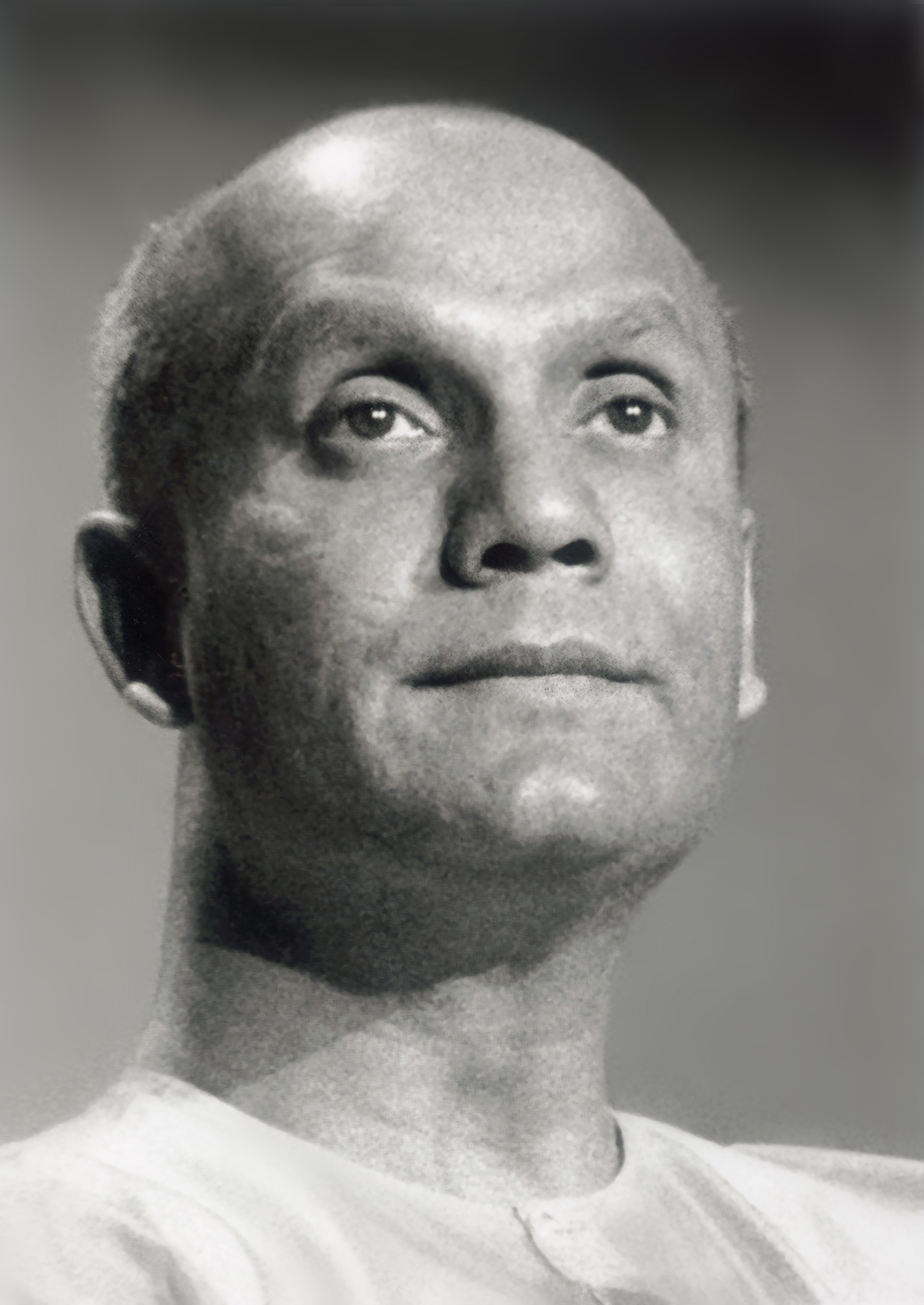
Sri Chinmoy taught a variety of meditation techniques aimed at calming and silencing the mind, purifying thoughts, and meditating on the spiritual heart. He explained that by keeping the mind calm and quiet for even ten or fifteen minutes, a new inner experience could begin to unfold, and this practice of stilling the mind forms the foundation of all spiritual progress.
He recommended meditating in the quiet atmosphere of the early morning, before the start of daily activities. While the traditional "hour of God," known as the Brahma Muhurta (between three and four a.m.), might not suit all modern lifestyles, Sri Chinmoy suggested that those new to meditation ideally practice before seven a.m. He taught that both prayer and meditation are vital, but they yield different results: prayer is an act of rising to God and speaking to the Divine, while meditation is the practice of stilling the mind to allow the divine presence to envelop and commune with the individual. He also suggested that reading spiritual writings or singing profound songs could help prepare for meditation or maintain a meditative state afterward.
Chinmoy believed that running and physical fitness were beneficial for both the inner spiritual life and outer active life, encouraging his followers to engage in daily running. He viewed running as a way to keep the body fit and clear the mind, and even as a form of external meditation.
2.3. Lifestyle and Discipline
Sri Chinmoy encouraged his disciples to adopt a vegetarian diet, abstain from recreational drugs including alcohol, and maintain a pure and celibate lifestyle, known as brahmacharya, for both married and unmarried devotees. He emphasized focusing on experiencing inner spiritual joy rather than external pleasures. While his teachings were influenced by Hinduism, his spiritual path was designed to appeal to an international community of seekers from diverse backgrounds. Unlike some older traditions that advocate complete withdrawal from the world, Chinmoy taught that such renunciation was not necessary for spiritual progress, but rather a "gradual and total Illumination of life."
2.4. Interfaith Dialogue
A cornerstone of Sri Chinmoy's teachings was a profound respect for other spiritual paths and religions. He articulated this by stating, "True religion has a universal quality. It does not find fault with other religions. ... Forgiveness, compassion, tolerance, brotherhood and the feeling of oneness are the signs of a true religion."
His dedication to promoting interfaith harmony led to significant invitations, including opening the Parliament of the World's Religions in Chicago in 1993 and in Barcelona in 2004 with a silent meditation. During the 2004 opening, he expressed his prayer "for the oneness of all religions." Although raised in the Hindu tradition, Sri Chinmoy often stated that his true religion was the "Love of God."
3. Activities and Contributions
Sri Chinmoy's extensive activities spanned global peace initiatives, prolific artistic creation, and the promotion of athleticism, all serving as practical expressions of his spiritual philosophy.
3.1. Peace Initiatives
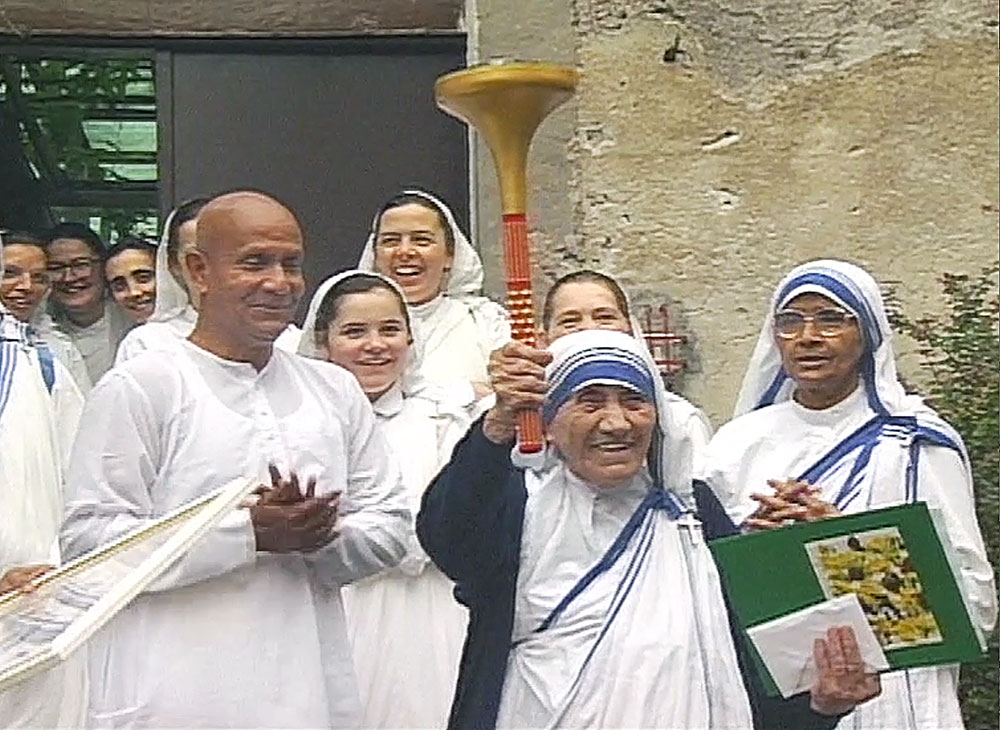
Sri Chinmoy dedicated many of his activities and the events he founded to the promotion of peace, earning him the description of an "ambassador of peace." He initiated the Sri Chinmoy Oneness-Home Peace Run in 1987, a global relay-style run where participants carry a flaming torch symbolizing harmony. He described this as a "grassroots effort for peace," emphasizing the theme of "Oneness Home" - the idea that all people are peace-longing citizens on a single planet. The Peace Run, which typically occurs every two years, was first launched at the World Trade Center in New York City. A precursor to this was the 1976 Liberty Torch Run, a relay involving 33 runners who covered 8.80 K mile (approximately 8.8 K mile (14.16 K km)) across 50 states in 7 weeks to mark America's bicentennial. The relay concluded in New York City, where Mayor Abraham Beame declared 16 August 1976, "Liberty Torch Day." Chinmoy's peace initiatives were not protests or political movements, but rather efforts to raise human consciousness about the necessity of peace, encapsulated by the slogan "Peace starts with me."
In 1991, Sri Chinmoy launched the 'Oneness Heart Tears and Smiles' humanitarian service, which dispatches food and medicine to those in need. By 2007, this organization had served 136 countries, with members of the Sri Chinmoy Centre distributing humanitarian aid globally. Working in collaboration with NGOs and governments, it provides health, medical, and educational supplies to recipient nations, supported by health professionals and private volunteers across five continents. Its programs include disaster relief, regional development, and the provision of health and medical supplies. The 'Kids to Kids' program, sponsored by Oneness Heart Tears and Smiles, encourages schoolchildren to assemble packs of school supplies and toys for disadvantaged children in other communities.
Chinmoy met with several world figures, including Mother Teresa on five separate occasions. During their second meeting in Rome in October 1994, Sri Chinmoy presented her with an award. Mother Teresa remarked, "I am so pleased with all the good work you are doing for world peace and for people in so many countries. May we continue to work together and to share together all for the glory of God and for the good of man." He also met with Diana, Princess of Wales, at Kensington Palace on 21 May 1997.
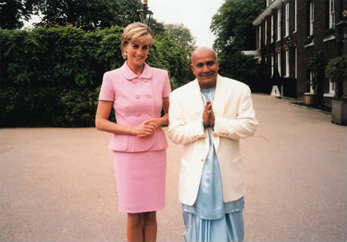
Following his death in 2007, more than 700 UN officials, ambassadors, members of the U.S. Congress, and representatives of various religions gathered at the UN headquarters in New York to pay tribute to Chinmoy. Mikhail Gorbachev stated that Chinmoy's death was a loss for the entire world, recognizing him as a man who dedicated his life to peace. Daw Aye Aye Thant, daughter of former UN Secretary-General U Thant, spoke at the celebration, quoting her father's 1972 letter to Chinmoy: "You have indeed instilled in the minds of hundreds of people here the moral and spiritual values which both of us cherish very dearly. I shall always cherish the memorable occasion of our meetings at the United Nations."
3.2. Artistic Pursuits
Sri Chinmoy was a prolific artist, composer, and poet, using these mediums as extensions of his spiritual expression and message of peace.
3.2.1. Artwork
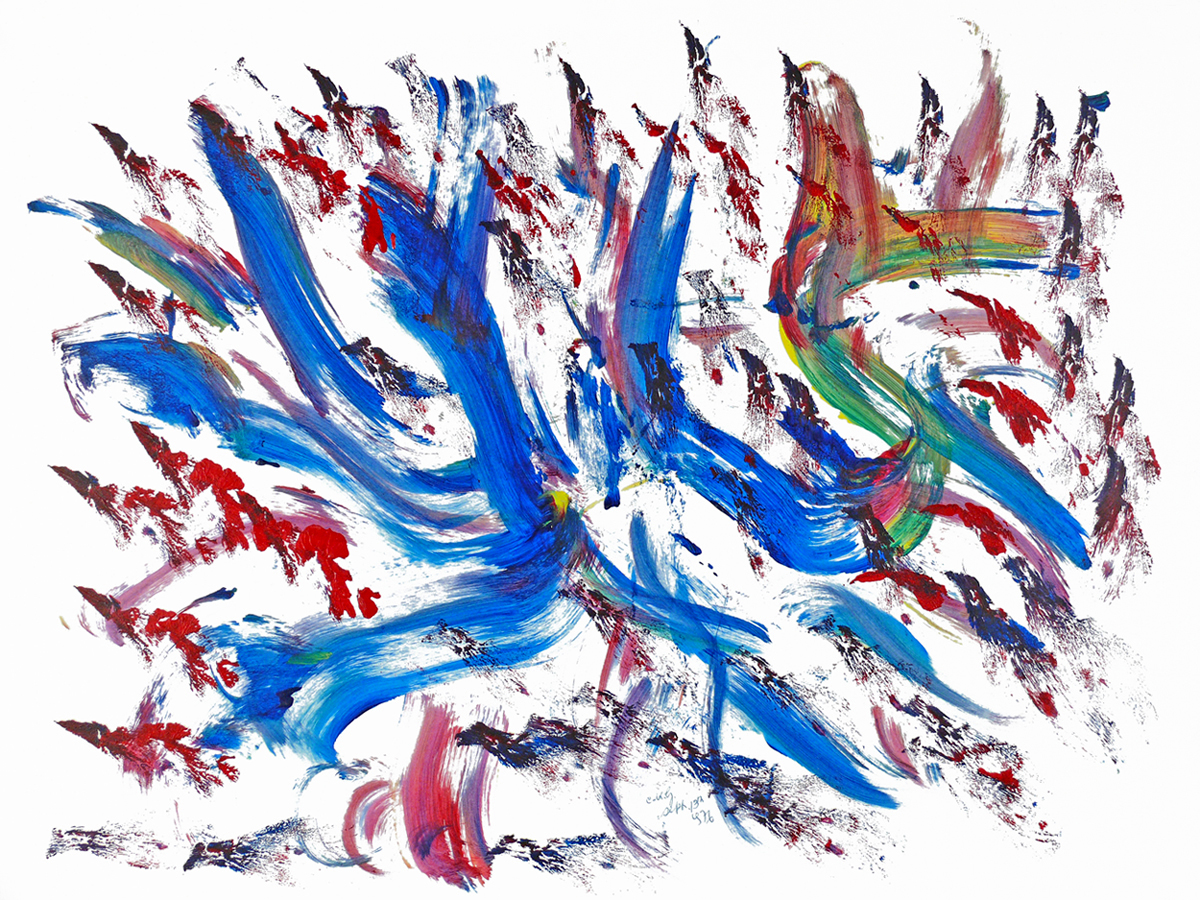
Sri Chinmoy began painting in 1974 during a visit to Ottawa, Canada. He named his artwork "Jharna Kala," meaning "Fountain Art" in Bengali, drawing inspiration from themes of universal oneness and peace. His abstract paintings, created with acrylics and pen drawings, utilized a variety of sponges, brushes, and colors, characterized by a mystical style, vigor, strong movement, and rhythm. Chinmoy stated that when he painted, he experienced a flow of creativity from the stillness of his meditation, allowing him to follow an inner inspiration or "streak of light."
In December 1991, Chinmoy initiated a new series of artworks titled "Dream-Freedom-Peace-Birds" or 'Soul Birds'. These bird drawings are often simple, Zen-like sketches, sometimes featuring a single bird or hundreds within a large drawing. Sri Chinmoy explained that these 'Soul Bird' drawings symbolize humanity's heart-cry for freedom.
His art has been exhibited in prestigious venues worldwide, including the UNESCO offices in Paris, London's Victoria and Albert Museum and the Mall Gallery, the Museum of Modern Art in Saint Petersburg, John F. Kennedy International Airport in New York, and the United Nations Headquarters.
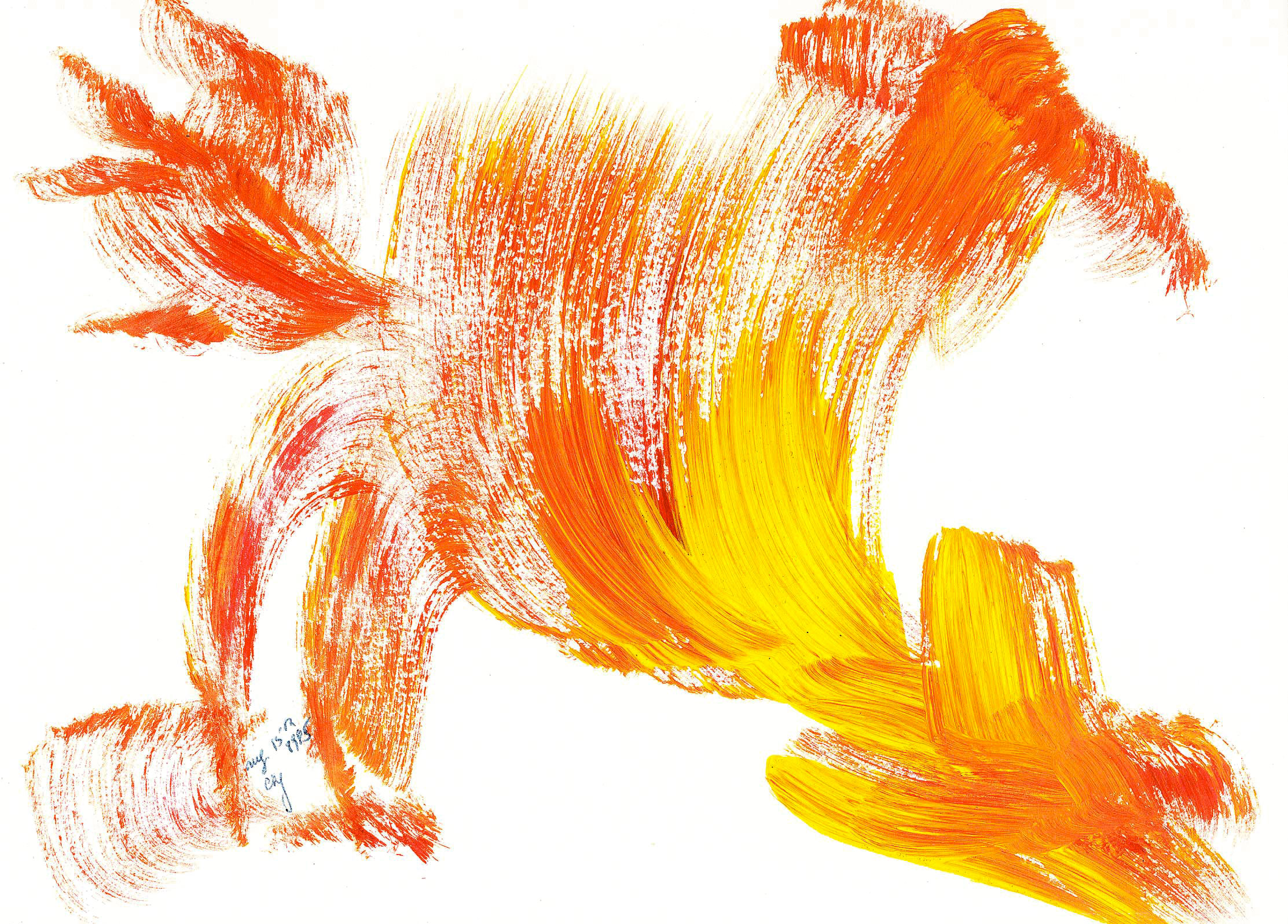
3.2.2. Music
Sri Chinmoy composed thousands of short musical pieces, with lyrics primarily in Bengali and English. Many of these compositions have been made available online through platforms like Sri Chinmoy Songs (lyrics and sheet music) and Radio Sri Chinmoy (audio). He released two albums in Jamaica on the Studio One subsidiary label Port-O-Jam. In 1976, he released a meditative album titled Music for Meditation on Folkways Records.
He also gave hundreds of free 'Peace Concerts' in renowned venues globally, including London's Royal Albert Hall, New York's Lincoln Center and Carnegie Hall, Tokyo's Nippon Budokan, the Eiffel Tower in Paris, and the Sydney Opera House. At these concerts, Sri Chinmoy played a diverse array of instruments, including the flute, esraj, piano, cello, sitar, and slide guitar, encompassing both Eastern and Western traditions.
3.2.3. Poetry
According to the Sri Chinmoy Centre, Sri Chinmoy published over 1,300 books, including 120,000 poems. Many of these poems are aphorisms-short, complete spiritual verses such as "We are all truly unlimited, if we only dare to try and have faith." Chinmoy also published volumes of longer, more classical-style poetry. In 2001, he recited his poetry at the United Nations as part of a UN-sponsored event promoting "Dialogue Among Civilizations Through Poetry."
His writing has garnered praise from many, including Archbishop Desmond Tutu, who wrote the foreword to Chinmoy's book The Jewels of Happiness. Tutu described the poems as "sweet gems of wisdom" and "timeless truths full of encouragement, love and goodness," stating that "These chapters fill us with indomitable hope and enthusiasm for life."
3.3. Athletics and Physical Fitness
Sri Chinmoy strongly advocated for athleticism as a means of self-transcendence, integrating physical fitness into his spiritual path.
3.3.1. Running
In 1977, the Sri Chinmoy Marathon Team was founded to organize running, swimming, and cycling events worldwide, ranging from fun runs to ultramarathons. Its precursor was the 1976 Liberty Torch Run, a relay race where 33 runners covered 8.80 K mile (approximately 8.8 K mile (14.16 K km)) in 7 weeks through 50 states, commemorating America's bicentennial. This concept expanded in 1987 to become the Sri Chinmoy Oneness-Home Peace Run, which is generally held every two years. The first Peace Run was launched in April 1987 at the World Trade Center in New York City.
In 1985, Sri Chinmoy, alongside the then-Mayor of Oxford, inaugurated the first "Sri Chinmoy Peace Mile" in Cutteslowe Park, Oxford. This measured mile provides joggers with a benchmark to track their progress. Numerous "Peace Miles" have since been established around the world. Many of Sri Chinmoy's followers incorporate daily running into their routines for health and physical fitness. Sri Chinmoy himself continued to participate in races until his 60s, when a knee injury limited his ability to run. Following this, he turned his attention to tennis and weightlifting.
He also founded the Self-Transcendence 6- & 10-day Races, which run concurrently in Queens each April, and the Self-Transcendence 3100 Mile Race, described by The New York Times as the "Mount Everest of ultramarathons." The Self-Transcendence Marathon, inaugurated in 2002, is held around the shores of Rockland Lake State Park in Congers, New York, north of New York City. This event, which attracts around 900 international runners, takes place in the last week of August.
Olympic gold medalist runner Carl Lewis was advised by Sri Chinmoy and learned meditation from him, practicing the techniques regularly. A devoted Christian, Lewis stated that his involvement with Sri Chinmoy was a step towards spiritual fulfillment that strengthened his Christian beliefs. In 2011, Lewis appeared in the short documentary Challenging Impossibility, which showcases Chinmoy's feats of strength. Members of the Sri Chinmoy Marathon Team have successfully swum the English Channel over 40 times. Other Chinmoy-sponsored athletic events include ultra-distance running, mountain climbing, and long-distance cycling. In 2010, Ashrita Furman, who holds over 150 Guinness World Records, credited the meditation he learned from Sri Chinmoy with helping him perform beyond his expectations.
3.3.2. Weightlifting
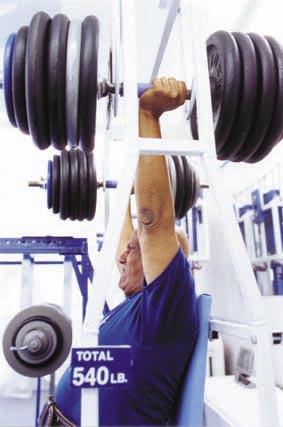
Sri Chinmoy began weightlifting in 1985 at the age of 54. His weightlifting feats involved an array of custom-designed objects and machinery, intended to challenge his strength and ability. Through these endeavors, he conveyed the message that "anything is possible if one is able to put aside the limitations of the mind." Bill Pearl, a former Mr. Universe, frequently served as the Master of Ceremonies at Chinmoy's strength exhibitions. In 1999, Pearl introduced one such exhibition by stating, "Today you are going to see some amazing feats of strength that I myself - and I have been in the industry for fifty-five years - would not even attempt to perform." Chinmoy stated that his motivation for lifting was to inspire others, particularly those of an older generation.
In 1998, Sri Chinmoy initiated a program called 'Lifting up the world with a Oneness Heart', where he would lift well-known individuals while they stood on an overhead platform. Chinmoy explained his motivation: "I lift them up to show my appreciation for their achievements." Among the approximately 7,000 people he lifted were prominent figures such as Nelson Mandela, Desmond Tutu, Muhammad Ali, Sting, Eddie Murphy, Susan Sarandon, Roberta Flack, Yoko Ono, Jeff Goldblum, Richard Gere, and Helen Hunt. He also lifted twenty Nobel laureates and a team of sumo wrestlers. In April 2011, a documentary film about Sri Chinmoy's weightlifting, titled Challenging Impossibility, was featured at the Tribeca Film Festival.
However, Terry Todd, a professor of kinesiology at the University of Texas, concluded that Sri Chinmoy misrepresented the type and weight of some of the lifts he claimed to have completed.
4. Controversy and Criticism
Despite his public image as a spiritual leader promoting peace and harmony, Sri Chinmoy and his organization have faced significant criticism and controversy, including allegations of cult-like practices and sexual impropriety.
4.1. Cult Allegations and Accusations
The Chinmoy group has been accused of being a cult by some, including former members and journalists. The 1994 book The Joy of Sects stated that "some of his followers left, however, amid accusations that Chinmoy was making sexual advances towards the wives of his disciples." More specific allegations of inappropriate sexual conduct were made by female former disciples in profiles published by San Diego CityBeat in 2005 and Salon.com in 2014. In February 2016, PIX 11 News in New York aired two segments on Chinmoy, during which one former follower alleged sexual impropriety. In response, the Sri Chinmoy Center's spokesperson issued a written statement asserting that "Our founder and teacher, Sri Chinmoy, led a life of the utmost purity and integrity." It is important to note that Sri Chinmoy was never sued or charged with any crime, and his lawyer denied the 2004 allegations at the time they were made.
4.2. Criticism of Self-Promotion and Other Issues
Some journalists and former followers have criticized what they perceived as Sri Chinmoy's obsessive or aggressive self-promotion.
In 2009, Jayanti Tamm, who was born into Chinmoy's organization, published Cartwheels in a Sari: A Memoir of Growing Up Cult, an account of her life as a Chinmoy disciple. Tamm claimed that Chinmoy had predicted she would become his perfect disciple, but she was later banished from the group at age 25. Her memoir details her experiences within the guru's inner circle and her struggle to break free from his influence. According to Tamm's book, Chinmoy prohibited sex, and most disciples were directed to remain single. The book also states that the guru discouraged secular education and imposed prohibitions against the consumption of alcohol, caffeine, and meat, as well as against dancing, dating, socializing with outsiders, and owning pets. Ironically, Tamm noted that Chinmoy himself maintained a collection of exotic pets in his Queens basement. Tamm acknowledged that the experiences and perceptions of the 7,000 other followers worldwide, and others who encountered Chinmoy, were likely to have been different from her own.
5. Awards and Recognition
Sri Chinmoy received numerous awards and recognitions for his contributions to peace, spirituality, and the arts throughout his life.
- Visva Sama Duta (Ambassador of Universal Peace): Conferred by the Asgiriya Order of Buddhist Monks in 1990. This marked the first time a non-Buddhist in Sri Lankan history received such an honorary degree.
- Mahatma Gandhi Universal Harmony Award: Received jointly with Coretta Scott King, widow of Martin Luther King Jr., from the American branch of the Indian cultural institute Bharatiya Vidya Bhavan in 1994.
- Fred Lebow Award: Presented in the name of the founder of the New York City Marathon by NYC Marathon Director Allan Steinfeld and Umberto Silvestri, President of the Rome Marathon, in 1996.
- Hindu of the Year (1997) and Hindu Renaissance Award: Presented by the international magazine Hinduism Today in 1997, honoring him for teaching a form of yoga that combines aspects of ancient Hinduism in a modern setting.
- Pilgrim of Peace prize: Awarded by the 'International Center of Assisi for Peace among Peoples' in 1998.
- Mother Teresa Award: Presented by President of the Republic of Macedonia Boris Trajkovski in 2001.
- Medal of Honor For the Cause of Peace and Friendship Among Nations: Presented by Vietnamese Ambassador to the United Nations Le Luong Minh in 2004.
- Honorary Doctorate of Humanities in Peace Studies: Conferred by the Science Council committee of Cambodia's International University in a unanimous decision in 2005.
- 2012 Class of Honorees: Inducted into the International Marathon Swimming Hall of Fame, recognizing the Sri Chinmoy Marathon Team for swimming the English Channel 38 times.
6. Death and Legacy
6.1. Death
Sri Chinmoy passed away from a heart attack on 11 October 2007, at his home in Jamaica, Queens, New York, at the age of 76. Until his death, he served as the spiritual leader to thousands of devoted followers worldwide.
6.2. Influence and Evaluation
Sri Chinmoy's death was mourned by many, including Mikhail Gorbachev, who stated that his passing was a loss for the entire world and that he would be remembered as a man who dedicated his whole life to peace. A posthumous celebration was held at the United Nations headquarters in New York, attended by over 700 UN officials, ambassadors, members of the U.S. Congress, and representatives of various religions, who paid tribute to Chinmoy. Daw Aye Aye Thant, the daughter of former UN Secretary-General U Thant, spoke at the ceremony, recalling her father's appreciation for Chinmoy's efforts to instill moral and spiritual values.
Sri Chinmoy did not charge fees for his spiritual guidance or music performances, and he maintained a respectful stance towards all religions and religious figures. His path, a contemporary system of yoga practiced under the guidance of a guru, emphasized a "gradual and total Illumination of life" rather than a complete withdrawal from the world for spiritual progress. His legacy is characterized by his extensive contributions to peace, interfaith understanding, the arts, and athleticism, alongside the controversies and criticisms that emerged regarding his organization's practices and his personal conduct.
7. Bibliography
7.1. Books and Poetry
- (1972) Arise! Awake! Thoughts of a Yogi - Frederick Fell Inc
- (1974) Yoga and the Spiritual Life - Aum Publications
- (1974) The Inner Promise: Paths to Self Perfection - Wildwood House
- (1974) Samadhi and Siddhi - The Summits of God Life - Aum Publications
- (1974) The Dance of Life - Volume 1 -20 - Agni Press
- (1975) Astrology, the Supernatural and the Beyond - Aum Publications
- (1977) Everest Aspiration - Aum Publications
- (1977) The Soul's Evolution - Agni Press
- (1979-1983) Ten Thousand Flower-Flames - Agni Press (100 volumes of poetry)
- (1983-1998) Twenty-Seven Thousand Aspiration-Plants - Agni Press (270 volumes of poetry)
- (1984) Inner and Outer Peace - Peace Publishing
- (1985) The Master and the Disciple - Insights into the Guru-Disciple Relationship - Agni Press
- (1986) A Child's Heart and a Child's Dreams - Aum Publications
- (1988) Beyond Within - Agni Press
- (1989) Meditation: Man-Perfection in God-Satisfaction - Aum Publications
- (1990) On Wings of Silver Dreams - Aum Publications
- (1992) Kundalini: The Mother-Power - Aum Publications
- (1992) Higher Meditation: A Journey to the Inner Self (Japanese translation)
- (1994) Garden of the Soul - Health Communications Inc.
- (1994) My Life's Soul-Journey - Aum Publications
- (1997) God Is... - Aum Publications
- (1997) The Wings of Joy: Finding Your Path to Inner Peace - Simon and Schuster
- (1998) Blessingful invitations from the university-world - Agni Press
- (1998-2007) Seventy-Seven Thousand Service-Trees - Agni Press (50 volumes of poetry, unfinished)
- (2000) Wisdom of Sri Chinmoy - Motilal Banarsidass Publ.
- (2000-2007) My Christmas-New Year-Vacation-Aspiration-Prayers (51 volumes of poetry)
- (2007) Power Within: Secrets of Spirituality and Ocultism - Guru Noka Publications
- (2007) Heart-Garden - New Holland Publishing
- (2009) A Selection of Songs composed by Sri Chinmoy, Vol. 1 - Sri Chinmoy Center
- (2010) The Jewels of Happiness - Watkins Publishing
- (2013) Sport and Meditation - The Golden Shore
7.2. Plays
- (1973) Sri Ramachandra - My Rama is My All - A play on the life of Sri Ramachandra
- (1973) The Singer of the Eternal Beyond - A play on the life of Sri Krishna
- (1973) Siddhartha Becomes The Buddha - A play on the life of Lord Buddha
- (1973) The Son - A play on the life of Jesus Christ
- (1973) Lord Gauranga: Love Incarnate - A play on the life of Sri Chaitanya
- (1973) Drink, Drink, My Mother's Nectar - A play on the life of Sri Ramakrishna
- (1973) The Heart of a Holy Man - Various plays on spiritual figures
- (1973) Supreme Sacrifice - A book of spiritual plays
- (1974) The Descent of the Blue - A play about the life of Sri Aurobindo
7.3. Music and Art Works
- (1974) Jharna Kala (Fountain Art) - Series of paintings and drawings.
- (1976) Music for Meditation - Album released on Folkways Records.
- (1991) "Dream-Freedom-Peace-Birds" or 'Soul Birds' - Series of bird drawings.
- Numerous musical compositions and recorded albums.